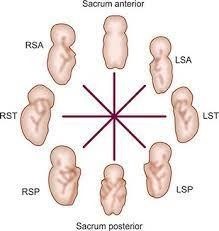A nurse is caring for a new mother who is breastfeeding her term newborn. The newborn weighed 3.4 kg (7.5 lb) at birth and weighed 3.3 kg (7.3 lb) on the second day of life. The mother expresses concern about the weight loss and asks the nurse about the amount of her breast milk. Which of the following responses by the nurse is appropriate?
"A healthy newborn can lose 6% of his birth weight before starting to gain weight."
"Why don't you switch to formula to make sure your baby is eating enough?"
"It is common for new mothers to worry that they are not making enough milk for their baby."
"Your newborn will need to remain in the hospital so his weight can be monitored."
The Correct Answer is A
Choice A rationale: Weight loss in the first few days after birth is normal for newborns, and a weight loss of up to 7-10% of the birth weight is considered within the expected range. A 6% weight loss is within normal limits, and it is reassuring to inform the mother that this is typical.
Choice B rationale: Suggesting switching to formula is not necessary based on the weight loss described. Breastfeeding provides adequate nutrition for most newborns, and early weight loss is typical and not a cause for alarm.
Choice C rationale: While it is true that new mothers may worry about breastfeeding and milk supply, this response does not address the specific weight loss concern and might not fully reassure the mother.
Choice D rationale: A 6% weight loss is within the expected range for a newborn and does not warrant hospitalization. It is a normal finding, and most newborns will start to regain their birth weight within a few days of life.
Nursing Test Bank
Naxlex Comprehensive Predictor Exams
Related Questions
Correct Answer is D
Explanation
Choice A rationale: Stopping breastfeeding is not an appropriate response to breast engorgement. Continuing to breastfeed frequently and effectively can help relieve the engorgement and ensure adequate milk supply.
Choice B rationale: While frequent breastfeeding is beneficial for both the baby and mother, this statement does not directly address breast engorgement.
Choice C rationale: Wearing a supportive bra during the daytime can actually help reduce breast engorgement and discomfort by providing gentle pressure and support to the breasts.
Choice D rationale: Breast engorgement is a common issue for breastfeeding mothers, especially during the early days after delivery. Applying cold compresses to the breasts before each feeding can help reduce swelling and discomfort associated with engorgement, making it easier for the baby to latch onto the breast.
Correct Answer is C
Explanation
Choice A rationale: A breech presentation means that the baby's buttocks or feet are the presenting part, not the shoulder.
Choice B rationale: Vertex presentation refers to a head-down position of the baby with the occiput (back of the head) as the presenting part. In the RSA position, the baby is in vertex presentation, but the specific part facing the mother's right side is the shoulder.
Choice C rationale: RSA (Right Sacrum Anterior) indicates that the fetus is in a vertex presentation with the head pointing down and the back of the baby's head (occiput) facing the mother's right side. The shoulder is the presenting part of this position.
Choice D rationale; Mentum refers to the chin of the baby. A mentum presentation (also called face presentation) means that the baby's face is the presenting part, not the shoulder.

Whether you are a student looking to ace your exams or a practicing nurse seeking to enhance your expertise , our nursing education contents will empower you with the confidence and competence to make a difference in the lives of patients and become a respected leader in the healthcare field.
Visit Naxlex, invest in your future and unlock endless possibilities with our unparalleled nursing education contents today
Report Wrong Answer on the Current Question
Do you disagree with the answer? If yes, what is your expected answer? Explain.
Kindly be descriptive with the issue you are facing.
